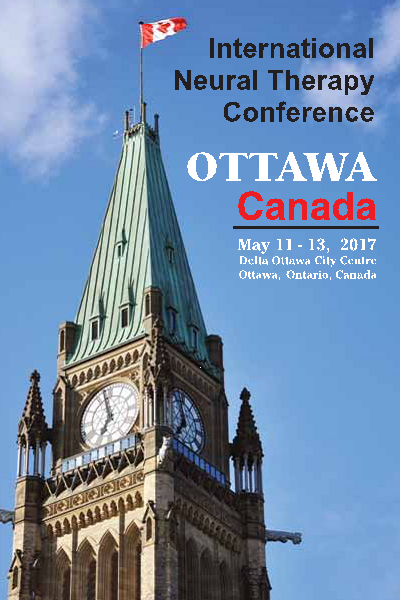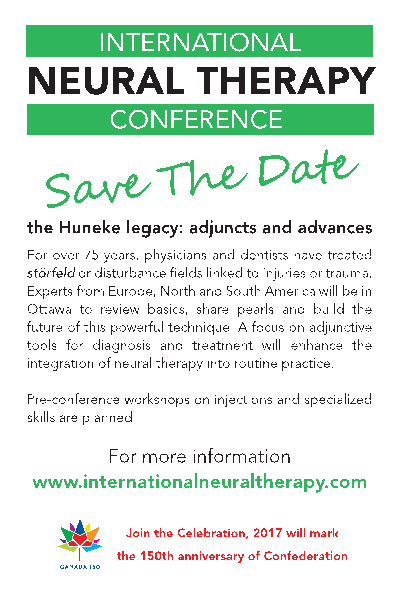|
Dear Colleagues: This month I would like to revisit the subject of autonomic response testing or ART. For those readers not yet familiar with the term, I have devoted a full chapter to it in my book: Neural therapy: Applied neurophysiology and other topics. ART is a tool in physical examination that can apply to many areas of medicine and particularly to neural therapy and osteopathy. In essence ART searches out the locations in the body that are under stress, or have been under stress in the past (tissue memory). Presumably in these locations, heightened (local) sympathetic tone is present, as if the nervous system is "on guard" against further threat. When the examiner's hand approaches the vulnerable spot, (perhaps a scar, an infected tooth, or a somatic dysfunction) the whole autonomic nervous system responds. The response can be observed by a change in pupil size, a change in heart rate or pulse amplitude, a change in indicator muscle tone, etc. Since the technique depends on observing a sympathetic response, it is important that the patient's body is not already in a state of heightened sympathetic tone. This can occur when the patient is unwell, or is under physical or emotional stress. The chapter in my book outlines methods to overcome these "blocks" and to achieve "open" (or "unblocked") regulation. In open regulation, the autonomic nervous system is parasympathetic-dominant, in a relaxed condition, and (in terms of oriental medicine) in a yin state. The advantage of being in this state for ART, is that the body is much more responsive to any stimulation because the sympathetic "noise" is at a minimum. Every effort should be made to achieve this state when searching for interference fields. However sometimes an inordinate amount of effort is required and valuable time is expended. This is when a "short-cut" is needed - something that will quickly put the patient into a relaxed, yin state. No doubt acupuncturists have their methods, and perhaps others, including hypnotists do, too. I would like to suggest a couple of methods that are quick and easy to learn. This first comes from osteopathy and is a tried and true "shotgun" method of treating all sorts of somatic dysfunction anywhere in the body. It is called the CV4, referring to a method of supposedly compressing the fourth ventricle of the cerebrospinal fluid system. The classical understanding of how it works is to "pump" the cerebrospinal fluid, thereby clearing mechanical restrictions in the spine and brain. The technique requires the patient to lie supine with the physician sitting at the head of the examining table and his or her hands cupped under the occiput. The weight of the skull rests on the physician's thenar eminences that are positioned bilaterally under the slight depressions superior to the nuchal ridge. After a minute or two a softening in the tissues will be sensed, the patient's breathing will become shallow and re-testing will confirm that the patient is now regulating. (for a more detailed description and explanation of this technique see pp.110-115 of Magoun's Osteopathy in the Cranial Field). A second method, even more reliably effective, is what I call a CV2. Here with the patient supine and the physician seated at the head of the examining table, the operator places his or her thumb-tips lightly on the scalp 1 cm apart and on both sides of the midline, perhaps 1 cm posterior to bregma (or the junction of the saggital and coronal sutures. The second, third and fourth fingers of each hand rest lightly on the upper temples. The thumbs and fingertips in these positions are "cradling" the first and second ventricles. Next, the physician feels for a very subtle movement of the thumbs together in an anterior or posterior direction, with the fingertips rotating in the opposite direction for up to 30 seconds. Then there is a pause of a few seconds, and the thumbs (and fingers) move together in the opposite direction. This continues as a very slow back and forth rocking movement, taking about 1 minute per cycle (much slower than the craniosacral or primary respiratory rhythm). Sometimes the thumbs do not move precisely together, one dragging behind the other or with a shorter amplitude per cycle. Asymmetry of movement indicates mechanical restriction of the cranial contents. This does not need to be treated at this time. Once the physician has "tuned in" to this movement, the movement on one side is resisted, while the other is allowed to continue as before. The side that is held can even be encouraged to move in the opposite direction, creating an oscillation where the two sides of the head (brain) are oscillating in opposite directions. Only one or two of these oscillations will put the body into a still point, i.e. a parasympathetic-dominant yin state. These techniques take a little practice, but are real time-savers in achieving a "regulating" state. Searches for interference fields or testing for systemic causes for blocked regulation are much more accurate and efficient when starting from a regulated state. ------------------------------------------------------------------------------------------- This newsletter marks the beginning of our 11th year - For those of you new to this newsletter there are now 120 (!) newsletters in the archive. First International Neural Therapy Conference in North America We are now only four weeks from the first International Neural Therapy conference in North America. Some spots still available in pre-conference workshops. Great line-up of speakers from Europe, North & South America!
--------------------------------------------------------------------------------------------- Third Heidelberg Neural Therapy Conference Heidelberg Germany |
|
A free Spanish language neural therapy newsletter is available, published by D. David Vinjes of Barcelona, Spain at http://www.terapianeural.com/. Sign up at the site! Discussions are underway with regard to translating both English and Spanish literature. Feedback with regard to interest is invited from you, the readership of this newsletter. Your feedback is always welcome. |
| Contact Information
~~~~~~~~~~~~~~~~~~~~~~~~~~~~~~~~~~~~~~~~~~~~~~~~ email: drkidd@neuraltherapybook.comphone: 613-432-6596 web: http://www.neuraltherapybook.com ~~~~~~~~~~~~~~~~~~~~~~~~~~~~~~~~~~~~~~~~~~~~~~~~ |

